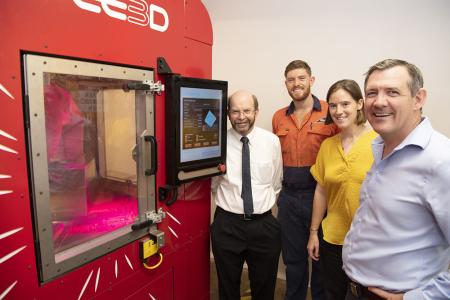News article
3D printing on Standards Australia’s radar
The significant advances in cold-spray 3D metal printing have been recognised with a representative of Charles Darwin University’s (CDU) Advanced Manufacturing Alliance being appointed to a body developing standards for the new process.
Using a LightSPEE3D printer’s cold spray technology, the Advanced Manufacturing Alliance (AMA) has produced parts that meet military specifications. The CDU-based AMA is an open alliance founded by the start-up company that invented the printer, SPEE3D, and CDU.
Chief Minister Michael Gunner received a briefing recently on developments in 3D printing technology from Vice-Chancellor Professor Simon Maddocks and AMA Director Dr Rebecca Murray.
Now AMA’s 3D Printing Systems Engineer, Micah Thorbjornsen has been selected as the chair of Standards Australia’s Committee for Additive Manufacturing. Mr Thorbjornsen studied Mechanical Engineering at CDU, graduating with honours in 2009.
“These standards are vital to 3D printing as a manufacturing process. Among other things, they give customers confidence about how a 3D-manufactured product will perform,” he said.
“Defence and resources are two sectors where there is huge scope for cold-spray technology, but both often operate equipment and systems to meet domestically and internationally recognised standards.
“We now have a seat at the table at Standards Australia that drafts those standards and that process can also feed into the drafting of international standards.”
The work will provide cold spray additive manufacturing, where Australian companies SPEE3D and Titomic are global leaders, to have pathways to certification for their technology and the associated materials and uses.
“At the moment, the standards relating to metal manufacturing have evolved over many, many years of using traditional processes such as casting or forging. They are just not readily applicable to new technology such as 3D metal printing,” Mr Thorbjornsen said.
“Yet 3D printing can produce parts that meet or exceed the material specifications of cast or forged products so there is a need to create standards that ensure the quality and reliability of 3D printed parts are similarly equivalent.
“With standards specific to cold spray, we will have an ability to demonstrate, in a transparent, repeatable and clearly articulated way, that 3D printed parts have the same or better qualities as traditionally manufactured parts.
“This will give customers confidence to use 3D printed parts and potentially fully unlock the potential of the technology to produce turn-key manufacturing solutions that can be used in a variety of processes and machines,” he said.
Related Articles

CDU mourns passing of beloved Territorian
Charles Darwin University acknowledges passing of distinguished judge, educator and former Administrator of the Northern Territory, the Honourable Austin Asche AC KC.
Read more about CDU mourns passing of beloved Territorian
Study reveals extreme rate of Australia’s invertebrate extinction
An estimated one to three species of insects and other native invertebrates are becoming extinct in Australia every week, according to a new study revealing the immense scale of the nation’s biodiversity loss.
Read more about Study reveals extreme rate of Australia’s invertebrate extinction
CDU PhD student receives Google’s backing to help Close the Gap
Australian research aimed at closing the gap in First Nations health outcomes through new and emerging technologies like AI has received the backing of Google.
Read more about CDU PhD student receives Google’s backing to help Close the Gap
